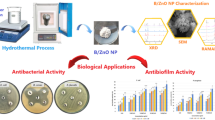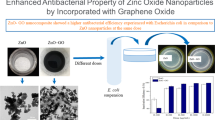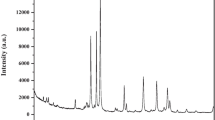Abstract
In this study, a graphene oxide material was fabricated using the Hummers process. RGO, ZnO, ZnO:B and RGO/ZnO:B nanoparticles were synthesized by the hydrothermal method in an autoclave at a temperature of 160 °C. The structural and morphological changes in the synthesized ZnO nanomaterials were investigated by preparing composite materials with a boron additive and RGO. The prepared nanoparticles were characterized by X-ray diffraction (XRD) and scanning electron microscopy (SEM). Antimicrobial and antibiofilm assays were performed to evaluate the biological activities of the synthesized nanoparticles. The antimicrobial activity of these NPs was investigated against Escherichia coli, Pseudomonas aeruginosa, Staphylococcus aureus, Bacillus cereus, Enterococcus faecalis and Staphylococcus epidermidis pathogenic bacteria. Among the nanoparticles tested, ZnO and ZnO:B NPs showed strong antimicrobial activity against clinically important E. coli, P. aeruginosa and B. cereus strains. The antibiofilm activity of the synthesized nanoparticles was determined using E. coli and P. aeruginosa strains. The biofilm inhibition of both strains by the ZnO:B nanocomposites was greater than that by the other nanocomposites. At a concentration of 20 mg/mL, the ZnO:B nanocomposite showed 42.13% biofilm inhibition of E. coli and 36.21% biofilm inhibition of P. aeruginosa. The RGO/ZnO:B nanocomposite had a specific inhibitory effect on E. coli (34.25%) and P. aeruginosa (30.16%). The antibiofilm effect of the nanocompounds used in the study was greater on E. coli than on P. aeruginosa. As a result, the synthesized boron-reinforced ZnO nanocomposites exhibited strong biological effects. These results will provide valuable information for the development of new treatment regimens for the inactivation of pathogenic bacteria.








Similar content being viewed by others
References
M.K.Y. Soliman, S.S. Salem, M. Abu-Elghait, M.S. Azab, Biosynthesis of Silver and Gold Nanoparticles and Their Efficacy Towards Antibacterial, Antibiofilm, Cytotoxicity, and Antioxidant Activities. Appl. Biochem. Biotechnol. 195(2), 1158–1183 (2023). https://doi.org/10.1007/s12010-022-04199-7
N. Jubair, M. Rajagopal, S. Chinnappan, N.B. Abdullah, A. Fatima, Review on the Antibacterial Mechanism of Plant-Derived Compounds against Multidrug-Resistant Bacteria (MDR). Evidence-based Complement. Altern. Med. 2021 (2021). https://doi.org/10.1155/2021/3663315
P. Singh, S. Pandit, C. Jers, A.S. Joshi, J. Garnæs, I. Mijakovic, Silver nanoparticles produced from Cedecea sp. exhibit antibiofilm activity and remarkable stability. Sci. Rep. 11(1), 1–13 (2021). https://doi.org/10.1038/s41598-021-92006-4
M.G. Kang, F. Khan, D.M. Jo, D.K. Oh, N. Tabassum, Y.M. Kim, Antibiofilm and Antivirulence Activities of Gold and Zinc Oxide Nanoparticles Synthesized from Kimchi-Isolated Leuconostoc sp. Strain C2. Antibiotics. 11(11) (2022). https://doi.org/10.3390/antibiotics11111524
E. Sánchez-López et al., Metal-based nanoparticles as antimicrobial agents: An overview. Nanomaterials 10(2), 1–39 (2020). https://doi.org/10.3390/nano10020292
G.T. Anand, R. Nithiyavathi, R. Ramesh, S. John Sundaram, K. Kaviyarasu, Structural and optical properties of nickel oxide nanoparticles: Investigation of antimicrobial applications. Surf Interfaces. 18(2019), 100460 (2020). https://doi.org/10.1016/j.surfin.2020.100460
P.P. Mahamuni et al., Synthesis and characterization of zinc oxide nanoparticles by using polyol chemistry for their antimicrobial and antibiofilm activity. Biochem. Biophys. Rep. 17(2018), 71–80 (2019). https://doi.org/10.1016/j.bbrep.2018.11.007
S.A. Khan, S. Shahid, A. Ayaz, J. Alkahtani, M.S. Elshikh, T. Riaz, Phytomolecules-coated NiO nanoparticles synthesis using abutilon indicum leaf extract: Antioxidant, antibacterial, and anticancer activities. Int. J. Nanomedicine 16, 1757–1773 (2021). https://doi.org/10.2147/IJN.S294012
V. Tsikourkitoudi, B. Henriques-Normark, G.A. Sotiriou, Inorganic nanoparticle engineering against bacterial infections. Curr. Opin. Chem. Eng. 38, 100872 (2022). https://doi.org/10.1016/j.coche.2022.100872
Q. Liang, F. Qiao, X. Cui, X. Hou, Controlling the morphology of ZnO structures via low temperature hydrothermal method and their optoelectronic application. Mater. Sci. Semicond. Process. 89(2018), 154–160 (2019). https://doi.org/10.1016/j.mssp.2018.09.007
S. Mohan, M. Vellakkat, A. Aravind, U. Reka, Hydrothermal synthesis and characterization of Zinc Oxide nanoparticles of various shapes under different reaction conditions. Nano Express 1(3), 30028 (2020). https://doi.org/10.1088/2632-959X/abc813
S. Elbasuney, G.S. El-Sayyad, H. Tantawy, A.H. Hashem, Promising antimicrobial and antibiofilm activities of reduced graphene oxide-metal oxide (RGO-NiO, RGO-AgO, and RGO-ZnO) nanocomposites. RSC Adv. 11(42), 25961–25975 (2021). https://doi.org/10.1039/d1ra04542c
M.I. Khan et al., Investigation of in vitro antibacterial and seed germination properties of green synthesized pure and nickel doped ZnO nanoparticles. Phys. B Condens. Matter 601(2020), 412563 (2021). https://doi.org/10.1016/j.physb.2020.412563
A.M. Shehabeldine et al., Potential Antimicrobial and Antibiofilm Properties of Copper Oxide Nanoparticles: Time-Kill Kinetic Essay and Ultrastructure of Pathogenic Bacterial Cells. Appl. Biochem. Biotechnol. 195(1), 467–485 (2023). https://doi.org/10.1007/s12010-022-04120-2
Y. Wang, X. Wang, L. Li, Y. Wu, Q. Yu, An experimental and theoretical study on the photocatalytic antibacterial activity of boron-doped TiO2 nanoparticles. Ceram. Int. 48(1), 604–614 (2022). https://doi.org/10.1016/j.ceramint.2021.09.139
T. Abdulrehman et al., Boron doped silver-copper alloy nanoparticle targeting intracellular S. Aureus in bone cells. PLoS ONE 15(4), 1–18 (2020). https://doi.org/10.1371/journal.pone.0231276
S. Archana et al., Synthesis of nickel oxide grafted graphene oxide nanocomposites - A systematic research on chemisorption of heavy metal ions and its antibacterial activity. Environ. Nanotechnology, Monit. Manag. 16(May), 100486 (2021). https://doi.org/10.1016/j.enmm.2021.100486
J. Xu et al., Antibiofilm Effect of Cinnamaldehyde-Chitosan Nanoparticles against the Biofilm of Staphylococcus aureus. Antibiotics 11(10), 1–13 (2022). https://doi.org/10.3390/antibiotics11101403
A.H. Hashem, S.H. Rizk, M.A. Abdel-Maksoud, W.H. Al-Qahtani, H. AbdElgawad, G.S. El-Sayyad, Unveiling anticancer, antimicrobial, and antioxidant activities of novel synthesized bimetallic boron oxide-zinc oxide nanoparticles. RSC Adv. 13(30), 20856–20867 (2023). https://doi.org/10.1039/d3ra03413e
R. Kucukosman et al., Boron-based magnesium diboride nanosheets preparation and tested for antimicrobial properties for PES membrane. Chemosphere 339 (2023). https://doi.org/10.1016/j.chemosphere.2023.139340
M. Umar et al., Designing of Te-doped ZnO and S-g-C3N4/Te-ZnO nanocomposites as excellent photocatalytic and antimicrobial agents. Polyhedron 245(May), 116664 (2023). https://doi.org/10.1016/j.poly.2023.116664
J.G. Cuadra et al., ZnO/Ag Nanocomposites with Enhanced Antimicrobial Activity. Appl. Sci. 12(10), 1–13 (2022). https://doi.org/10.3390/app12105023
R. Ahmadi, R. Fattahi Nafchi, P. Sangpour, M. Bagheri, E. Badiei, A comparative study: Green synthesis and evaluation of ZnO-GO and ZnO-RGO nanocomposites for antibacterial applications. Mater. Sci. Eng. B 294(2022), 116555 (2023). https://doi.org/10.1016/j.mseb.2023.116555
A. Al Baroot, M. Alheshibri, Q.A. Drmosh, S. Akhtar, E. Kotb, K.A. Elsayed, A novel approach for fabrication ZnO/CuO nanocomposite via laser ablation in liquid and its antibacterial activity: A novel approach for fabrication ZnO/CuO nanocomposite, Arab. J. Chem. 15(2), . 103606 (2022). https://doi.org/10.1016/j.arabjc.2021.103606
A.A. Menazea, N.S. Awwad, Antibacterial activity of TiO2 doped ZnO composite synthesized via laser ablation route for antimicrobial application. J. Mater. Res. Technol. 9(4), 9434–9441 (2020). https://doi.org/10.1016/j.jmrt.2020.05.103
E. Kiray, Antibiofilm and Anti-Quorum Sensing Activities of Vaginal Origin Probiotics. Eur. J. Biol. 80(2), 82–90 (2021). https://doi.org/10.26650/EurJBiol.2021.932640
B. Kowalska-Krochmal, R. Dudek-Wicher, The minimum inhibitory concentration of antibiotics: Methods, interpretation, clinical relevance. Pathogens 10(2), 1–21 (2021). https://doi.org/10.3390/pathogens10020165
N.A. Theodora, V. Dominika, D.E. Waturangi, Screening and quantification of anti-quorum sensing and antibiofilm activities of phyllosphere bacteria against biofilm forming bacteria. BMC. Res. Notes 12(1), 10–14 (2019). https://doi.org/10.1186/s13104-019-4775-1
V. Gupta, N. Sharma, U. Singh, M. Arif, A. Singh, Higher oxidation level in graphene oxide. Optik (Stuttg) 143, 115–124 (2017). https://doi.org/10.1016/j.ijleo.2017.05.100
J. Guerrero-Contreras, F. Caballero-Briones, Graphene oxide powders with different oxidation degree, prepared by synthesis variations of the Hummers method. Mater. Chem. Phys. 153, 209–220 (2015). https://doi.org/10.1016/j.matchemphys.2015.01.005
R.M. Nauman Javed, A. Al-Othman, M. Tawalbeh, A.G. Olabi, Recent developments in graphene and graphene oxide materials for polymer electrolyte membrane fuel cells applications. Renew. Sustain. Energy Rev. 168(January), 112836 (2022). https://doi.org/10.1016/j.rser.2022.112836
V. Sharma, Y. Jain, M. Kumari, R. Gupta, S.K. Sharma, K. Sachdev, Synthesis and Characterization of Graphene Oxide (GO) and Reduced Graphene Oxide (rGO) for Gas Sensing Application. Macromol. Symp. 376(1), 1–5 (2017). https://doi.org/10.1002/masy.201700006
R. Al-Gaashani, A. Najjar, Y. Zakaria, S. Mansour, M.A. Atieh, XPS and structural studies of high quality graphene oxide and reduced graphene oxide prepared by different chemical oxidation methods. Ceram. Int. 45(11), 14439–14448 (2019). https://doi.org/10.1016/j.ceramint.2019.04.165
M. Muniyalakshmi, K. Sethuraman, D. Silambarasan, Synthesis and characterization of graphene oxide nanosheets. Mater. Today, Proc. 21, 408–410 (2020). https://doi.org/10.1016/j.matpr.2019.06.375
T. Hurma, Effect of boron doping concentration on structural optical electrical properties of nanostructured ZnO films. J. Mol. Struct. 1189, 1–7 (2019). https://doi.org/10.1016/j.molstruc.2019.03.096
M.J. Chithra, M. Sathya, K. Pushpanathan, Effect of pH on crystal size and photoluminescence property of zno nanoparticles prepared by chemical precipitation method. Acta Metall. Sin. English Lett. 28(3), 394–404 (2015). https://doi.org/10.1007/s40195-015-0218-8
N. Kumaresan, K. Ramamurthi, R. Ramesh Babu, K. Sethuraman, S. Moorthy Babu, Hydrothermally grown ZnO nanoparticles for effective photocatalytic activity. Appl. Surf. Sci. 418, 138–146 (2017). https://doi.org/10.1016/j.apsusc.2016.12.231
S.B. Ghaffari, M.H. Sarrafzadeh, M. Salami, M.R. Khorramizadeh, A pH-sensitive delivery system based on N-succinyl chitosan-ZnO nanoparticles for improving antibacterial and anticancer activities of curcumin. Int. J. Biol. Macromol. 151, 428–440 (2020). https://doi.org/10.1016/j.ijbiomac.2020.02.141
R. Niranjan, S. Zafar, B. Lochab, R. Priyadarshini, Synthesis and Characterization of Sulfur and Sulfur-Selenium Nanoparticles Loaded on Reduced Graphene Oxide and Their Antibacterial Activity against Gram-Positive Pathogens. Nanomaterials 12(2) (2022). https://doi.org/10.3390/nano12020191
O. Usman et al., Enhanced Bactericidal Action of rGO-ZnO Hybrids Prepared by the One-Pot Coprecipitation Approach. ACS Omega 7(30), 26715–26722 (2022). https://doi.org/10.1021/acsomega.2c03049
D. Kichukova, I. Spassova, A. Kostadinova, A. Staneva, D. Kovacheva, Facile Synthesized Cu–RGO and Ag–RGO Nanocomposites with Potential Biomedical Applications. Nanomaterials 12(12) (2022). https://doi.org/10.3390/nano12122096
V. Ahmad, M.O. Ansari, Synthesis, Characterization, and Evaluation of Antimicrobial Efficacy of Reduced Graphene–ZnO–Copper Nanocomplex. Antibiotics 12(2) (2023). https://doi.org/10.3390/antibiotics12020246
M.J. Klink, N. Laloo, A.L. Taka, V.E. Pakade, E. Monapathi, J.S. Modise, Synthesis , Characterization and Antimicrobial Activity of Zinc Yeast Pathogens. (2022)
D.V. Francis, M.N. Jayakumar, H. Ahmad, T. Gokhale, Antimicrobial Activity of Biogenic Metal Oxide Nanoparticles and Their Synergistic Effect on Clinical Pathogens. Int. J. Mol. Sci. 24(12) (2023). https://doi.org/10.3390/ijms24129998
W.M. Abdelraheem, E.S. Mohamed, The effect of Zinc Oxide nanoparticles on Pseudomonas aeruginosa biofilm formation and virulence genes expression. J. Infect. Dev. Ctries. 15(6), 826–832 (2021). https://doi.org/10.3855/jidc.13958
W.M. Abdelraheem, R.M.M. Khairy, A.I. Zaki, S.H. Zaki, Effect of ZnO nanoparticles on methicillin, vancomycin, linezolid resistance and biofilm formation in Staphylococcus aureus isolates. Ann. Clin. Microbiol. Antimicrob. 20(1), 1–11 (2021). https://doi.org/10.1186/s12941-021-00459-2
Y. Zheng, X.K. Li, Y. Wang, L. Cai, The role of zinc, copper and iron in the pathogenesis of diabetes and diabetic complications: Therapeutic effects by chelators. Hemoglobin 32(1–2), 135–145 (2008)
H. Yang et al., Synthesis of boron carbonitride nanosheets using for delivering paclitaxel and their antitumor activity. Colloids Surf. B Biointerfaces 198(2020), 111479 (2021). https://doi.org/10.1016/j.colsurfb.2020.111479
F. Yang, M. Zhu, J. Zhang, H. Zhou, Synthesis of biologically active boron-containing compounds. Medchemcomm 9(2), 201–211 (2018). https://doi.org/10.1039/c7md00552k
Y. Zhu, P. Prommana, N.S. Hosmane, P. Coghi, C. Uthaipibull, Y. Zhang, Functionalized Boron Nanoparticles as Potential Promising Antimalarial Agents. ACS Omega 7(7), 5864–5869 (2022). https://doi.org/10.1021/acsomega.1c05888
H. Türkez et al., Lipoic Acid Conjugated Boron Hybrids Enhance Wound Healing and Antimicrobial Processes. Pharmaceutics 15(1) (2023). https://doi.org/10.3390/pharmaceutics15010149
A.I. El-Batal, G.S. El-Sayyad, N.E. Al-Hazmi, M. Gobara, Antibiofilm and Antimicrobial Activities of Silver Boron Nanoparticles Synthesized by PVP Polymer and Gamma Rays Against Urinary Tract Pathogens. J. Clust. Sci. 30(4), 947–964 (2019). https://doi.org/10.1007/s10876-019-01553-4
N.F. Andrade Neto, P. Zanatta, L.E. Nascimento, R.M. Nascimento, M.R.D. Bomio, F.V. Motta, Characterization and Photoluminescent, Photocatalytic and Antimicrobial Properties of Boron-Doped TiO 2 Nanoparticles Obtained by Microwave-Assisted Solvothermic Method. J. Electron. Mater. 48(5), 3145–3156 (2019). https://doi.org/10.1007/s11664-019-07076-y
Author information
Authors and Affiliations
Corresponding author
Ethics declarations
Researcher Contribution Rate Statement Summary
The authors declare that they have contributed equally to the article.
Conflict of Interest Statement
The authors declare that they have no conflicts of interest.
Additional information
Publisher's Note
Springer Nature remains neutral with regard to jurisdictional claims in published maps and institutional affiliations.
Rights and permissions
Springer Nature or its licensor (e.g. a society or other partner) holds exclusive rights to this article under a publishing agreement with the author(s) or other rightsholder(s); author self-archiving of the accepted manuscript version of this article is solely governed by the terms of such publishing agreement and applicable law.
About this article
Cite this article
Tekerek, S., Tanrıverdi, A., Kiray, E. et al. Biological Activities of Boron and Reduced Graphene Oxide-Based Zinc Oxide Nanocomposites (ZnO:B and RGO/ZnO:B) Synthesized by an Environmentally Friendly Method. Braz J Phys 54, 35 (2024). https://doi.org/10.1007/s13538-023-01415-5
Received:
Accepted:
Published:
DOI: https://doi.org/10.1007/s13538-023-01415-5




